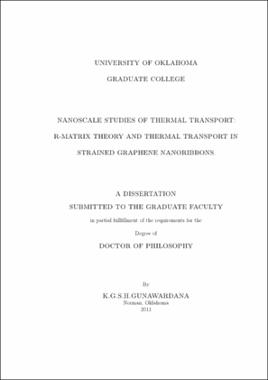| dc.contributor.advisor | Mullen, Kieran | |
| dc.creator | Gunawardana, K.G. Samantha Harshadewa | |
| dc.date.accessioned | 2019-04-27T21:32:13Z | |
| dc.date.available | 2019-04-27T21:32:13Z | |
| dc.date.issued | 2011 | |
| dc.identifier | 99278947902042 | |
| dc.identifier.uri | https://hdl.handle.net/11244/318947 | |
| dc.description.abstract | The rapid development of nanotechnology has enabled the fabrication of structures much smaller than the mean free path of electrons and phonons. In modern electronics, miniaturization is desired to increase the transistor density and the clock speed. Electronic transport on the nanoscale has been studied for over three decades and fascinating quantum effects have been observed. Phonon transport on this scale is of significant interest because of the increased power dissipation in nanoelectronics, which undermines the correct functionality of devices and limits their lifetime. Apart from the effort to minimize heat generation, an efficient heat management scheme is necessary. | |
| dc.description.abstract | Historically, thermal transport in bulk materials was described by the Fourier's law, in which the thermal conductivity is an intrinsic property of the material. Later a more descriptive model, the Boltzmann approach for thermal transport, was developed and could explain the thermal conductivity down to a 100 nm length scale at high temperatures. At low temperatures and in structures smaller than roughly 100 nm, thermal transport is described by the fully quantum mechanical Landauer-Butticker formalism. In this context, accurate calculation of phonon transmission probabilities is very important. | |
| dc.description.abstract | In this dissertation, I develop a continuum model to calculate phonon transmission probabilities between media, which have high contrast in the elastic properties. In this work, we include an interface transition layer between the two media and look for interface properties that improve thermal transport. | |
| dc.description.abstract | Secondly, I develop a new theoretical tool based on the R-Matrix theory to calculate phonon transmission probabilities on the atomic scale. R-matrix theory is a well developed theoretical approach commonly used in nuclear and atomic physics to solve scattering problems. Recently, this approach has been successfully developed to calculate electronic scattering in mesoscopic quantum devices. The key novelty of R-matrix theory for phonons is that the only required information about the scattering region is its normal modes, which are evaluated only once for a system. This approach is computationally efficient and produces the same results as the modern technique based on the non-equilibrium Green's function (NEGF) approach. I present a detailed theoretical explanation of this approach and results applying to graphene nanoribbons. This theoretical development is presented focusing on two terminals devices while the extension to the devices with multiple leads is straightforward. | |
| dc.description.abstract | Finally, I use molecular dynamics to study the thermal transport properties of strained graphene nanoribbons. I find that the thermal conductivity of zigzag graphene nanoribbons shows a weak dependence on moderate tensile strains, while that of armchair graphene nanoribbons decreases significantly. This is a promising feature in strain-induced device applications. Furthermore, we observe significant thermal rectification (over 70 %) in a rectangular armchair graphene nanoribbon by applying a transverse force asymmetrically. The heat flux is larger from the less stressed region to the more stressed region. These findings can potentially enable real-time tuning of the thermal rectification by a mechanical force in nanostructures. | |
| dc.format.extent | 136 pages | |
| dc.format.medium | application.pdf | |
| dc.language | en_US | |
| dc.relation.requires | Adobe Acrobat Reader | |
| dc.subject | Nanostructured materials--Transport properties | |
| dc.subject | Phonons | |
| dc.subject | Nanotechnology | |
| dc.title | Nanoscale studies of thermal transport: R-matrix theory and thermal transport in strained graphene nanoribbons. | |
| dc.type | text | |
| dc.type | document | |
| dc.thesis.degree | Ph.D. | |
| ou.group | College of Arts and Sciences::Homer L. Dodge Department of Physics and Astronomy | |
